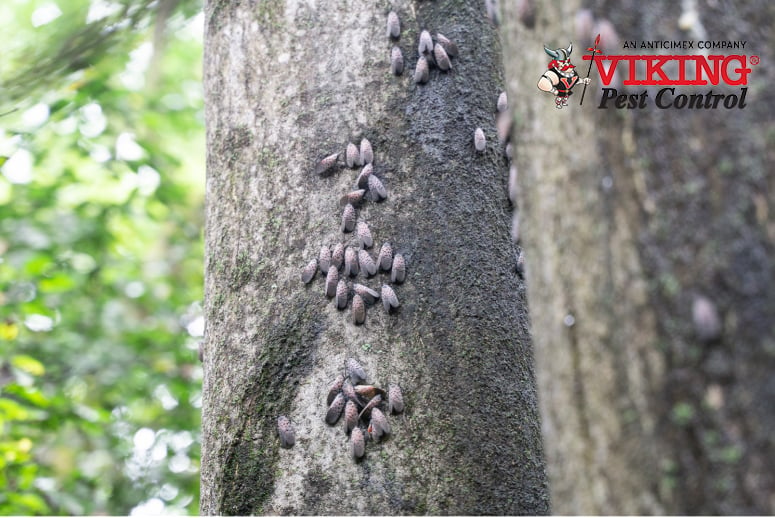Everything You Need to Know About Spotted Lanternflies in Pennsylvania

What are spotted lanternflies?
Spotted lanternflies (Lycorma delicatula) are planthoppers from the order Hemiptera like our native aphids, cicadas, or leafhoppers. We have many native species of planthoppers in the US. Spotted lanternflies, however, are native to countries in South East Asia. However, in the more recent years Spotted Lanternflies have become problematic in Pennsylvania.
Do spotted lanternflies bite?
No, they cannot. Their mouthparts, which are fused into a straw-like beak that they insert into plant tissue to suck up sap (phloem), are not capable of penetrating human skin. We have heard several stories of and from people who think they have been bitten by a spotted lanternfly, but couldn’t swear that they either saw the physical bite take place, or that it wasn’t a horsefly, mosquito or other such native insect. We have personally been in highly infested areas and literally covered with dozens of spotted lanternflies at a time, and have never been bitten. The only thing close to a bite we have experienced is a pinch or poke from the legs of the lanternflies hanging on to us. (Check out the picture of the tarsal claw in our photo section)
Can spotted lanternflies damage my house?
No, not directly in the manner that termites or carpenter ants can do structural damage. There can be secondary damage in the form of sooty mold, egg mass residue and similar issues.
Why are they in my Pennsylvania neighborhood?
Several years ago, (September 22, 2014) they were discovered in southern Berks County, Pennsylvania. They probably arrived as an egg mass, stuck to a pallet or similar packing material and were received by an unsuspecting recipient who did not notice them. We suspect that they were introduced several years before they were first detected in September 2014. Since then they have been breeding and spreading.
What do they do?
They hatch in the spring as wingless nymphs. The nymphs hop around and feed, molting several times before their final molt into adults that can fly. In the first three stages, nymphs are black with white spots and can be easy to overlook, as they are small and look somewhat like ants. In the fourth stage, the nymphs are more conspicuous as they are larger and red in coloration. The final molt into adults begins somewhere around the third week of July, but individuals can remain in the late nymph stage as late as October. The adults then begin to migrate out to new areas (especially on warm, breezy days) from the end of July through October. Around the third week in September, they begin mating, and then they lay eggs. The eggs are laid in groups and the groups are contained in a plaster-like covering in masses. The adults will continue to feed intermittently after egg laying, and hang around until a heavy frost kills them. Undisturbed egg masses will overwinter and then hatch out in the spring, continuing the cycle. Each egg mass usually contains 30-50 eggs and we believe a female can lay 2-3 egg masses before they die.
What do spotted lanternflies eat?
Spotted lanternflies eat sap from plants. They prefer Ailanthus trees (tree of heaven), walnuts, and grapevines as a first choice, most any other hardwood tree as a second choice, and with much less frequency, pine trees. They have a very wide range of host plants.
How do they eat?
Spotted lanternflies feed by sucking sap from plants with a straw-like mouthpart called a proboscis. The proboscis is located between the two front legs. Spotted lanternflies do not have chewing or biting mouthparts. They do not have stingers. They do not chew on leaves. They likely utilize small existing holes in tree stems and trunks that are so small, they are nearly microscopic.
Why are they on my house?
Spotted lanternflies take advantage of any structure to rest or climb on. They have no interest in your house, it’s just in their way. They also like to gather on warm house surfaces when the weather is cool. We have even observed them climbing telephone poles in areas without tall trees. Once at the top of the poles, they spread their wings and take advantage of the height to fly further distances.
Can they fly?
Spotted lanternflies can fly very well. They are not agile like a dragonfly or housefly, but more like a moth. Early on, people first encountering them reported them as “not able to fly far, but short distances similar to a grasshopper”. While they are powerful hoppers (hence the term planthopper), additional observations have changed this notion. They can fly relatively high and far, but not with any great level of agility. They also tend to crash land. On a hot, breezy day they can be seen crashing into houses, cars, trees, or anything else that they encounter.
Are they eating my trees?
What do spotted lanternflies eat is probably one of the most asked questions about the spotted lanternfly. This is a difficult question to answer. Spotted lanternflies are known to “host” (feed) on many different hardwood trees that we have in our landscape. That said, they tend to have preferred choices that they feed on, such as Ailanthus, walnuts, or grapevines. This means that they will choose certain species first if possible, but settle for what is available. Often on a given property, amongst trees of the same species, there will be preferred specimens, meaning that of three silver maples one is absolutely covered with spotted lanternflies, and the remaining two are not. This is what we call a “hot tree” and we can use this fact to our advantage killing spotted lanternflies.
Are spotted lanternflies killing my trees?
We believe that they probably are. This is literally the multi-billion-dollar question when it comes to Pennsylvania’s hardwood forests (Pennsylvania is the number one exporting state for hardwoods), grape industry (number 5 nationally), apples (number 3 nationally) and landscapes regarding spotted lanternflies. There are some indications that continued intensive feeding after several years can kill a tree, especially younger or stressed trees. The best way to consider this question is in light of the fact that they are drinking sap, which is the life blood of the tree. A healthy tree in a wet year can give up lots of sap before it is a concern (think maple syrup), however persistent heavy feeding (especially on a “hot tree” loaded with thousands of adults) may greatly weaken a tree, making it susceptible to other insects or diseases, or maybe killing it outright. Unfortunately, we are going to find this out the hard way. There is always a risk that they may become a vector for transmitting a disease from tree to tree.
Why is my tree “raining”?
Spotted lanternflies suck sap and digest it, concentrating the sap into a sugar rich excretion (urine) that is politely termed “honeydew” in the entomological vernacular. The “rain” you are seeing is actually a high volume of spotted lanternfly honeydew falling from the branches above. In some cases we have seen infestations so bad that we prefer to wear a rain coat when working under the trees. If you have a large tree that is raining spotted lanternfly honeydew and you care about the tree, you should seek professional help to clear the tree.
What is honeydew?
Honeydew is the polite term for the liquid waste excretions of sap sucking insects such as spotted lanternflies. With spotted lanternflies it is clear, sticky and sugar rich. Honeybees, yellow jackets, butterflies and other sugar gathering insects have been observed gathering honeydew directly from the anuses of spotted lanternflies. On a heavily infested tree, the trunk can be seen almost swarming with honeybees and yellow jackets trying to collect the honeydew.
Why is my tree/ porch/ deck/ etc. turning black?
When you see a black coating beneath a tree infested with spotted lanternflies, you are actually looking at a fungus called “sooty mold” that is growing on the sugar rich honeydew dripping from the spotted lanternflies in the tree above. Sooty mold is mainly a nuisance, but in some extreme situations has actually smothered out understory plants beneath the trees. It is unpleasant and requires lots of elbow grease to remove from patios, decks and lawn furniture.
Why are there so many spotted lanternflies in Pennsylvania?
The simple answer is because they breed in large numbers and very few native predators will eat them. We have witnessed spiders eat them when they can catch them in webs, praying mantis eat them, when they can catch them, and yellow jackets actually seeming to eat dead spotted lanternflies. They don’t seem to attack live ones however. In their native countries, there are probably multiple predators that keep their populations in check.
What else eats spotted lanternflies?
The short answer is not much. We have heard reports of different types of birds being seen eating them, but not in any great numbers. We also find spotted lanternflies with missing wings and legs that could indicate a bird “tasting” them and spitting them out. We gave them the “chicken test”. As anyone who has owned chickens knows, chickens will eat pretty much any insect they encounter with great enthusiasm. When we tried feeding spotted lanternflies to our chickens, they came running to see what the prize was and then turned their backs on them. This seems to indicate that they are unpalatable to birds, but more research is needed beyond the chicken test. Some general predators have been observed eating spotted lanternflies, such as praying mantis, wheel bugs and spiders. Unfortunately the numbers of lanternflies are too overwhelming for those predators to have a significant impact at this point.
About Viking Pest Control
The Spotted Lanternfly was first discovered in Pennsylvania in 2014. They are believed to have been introduced from South East Asia around 2012. Since 2014, they have spread to more than seven states including parts of Pennsylvania, New Jersey and Delaware. Viking Pest offers a specialized treatment specifically for Spotted Lanternflies. This treatment is currently only available for Pennsylvania residents. Viking’s Spotted Lanternfly treatment is specially formulated to prevent harming to non-target wildlife like squirrels and birds. Please contact Viking Pest for more information about our Spotted Lanternfly service plan and to see if it is available in your area.












